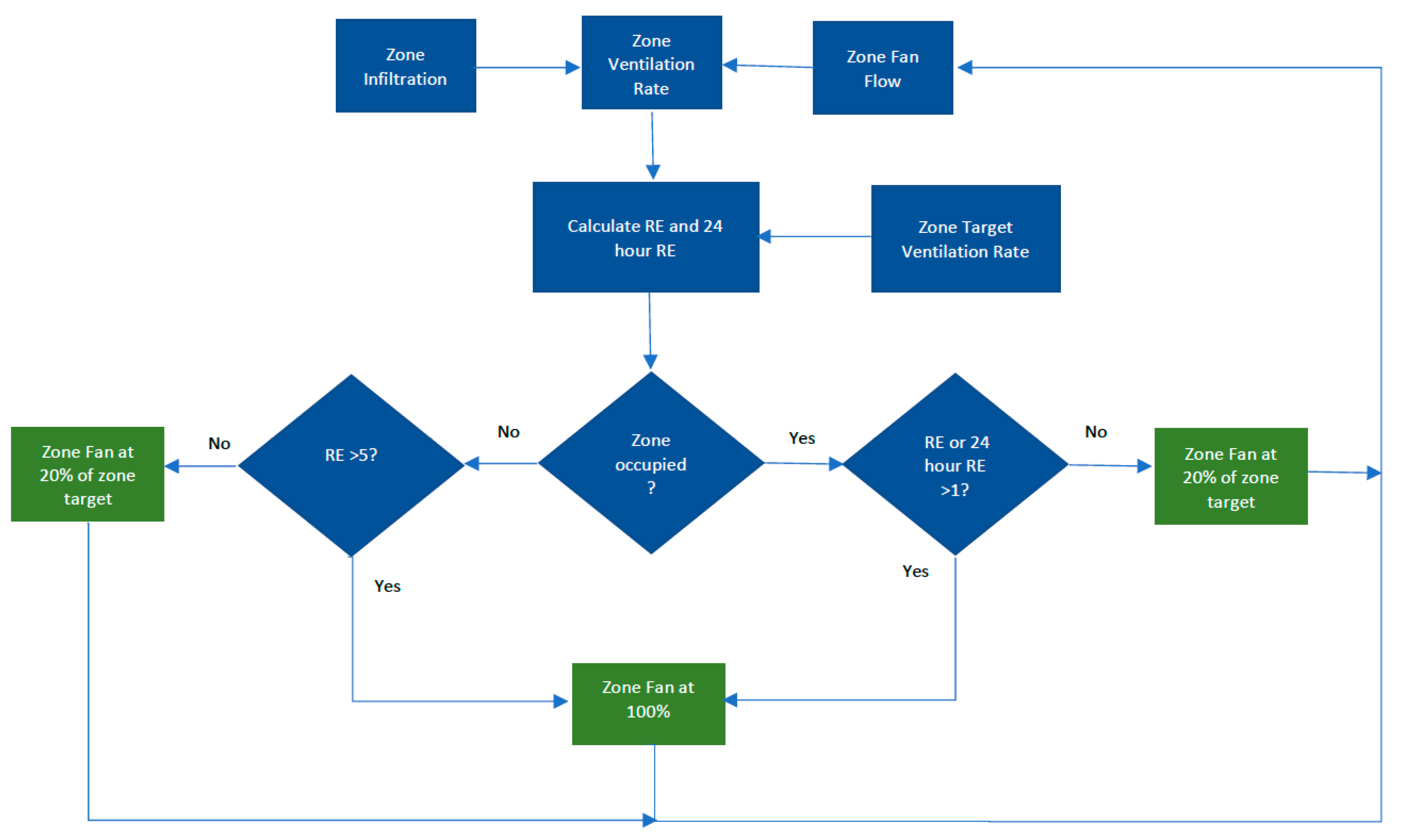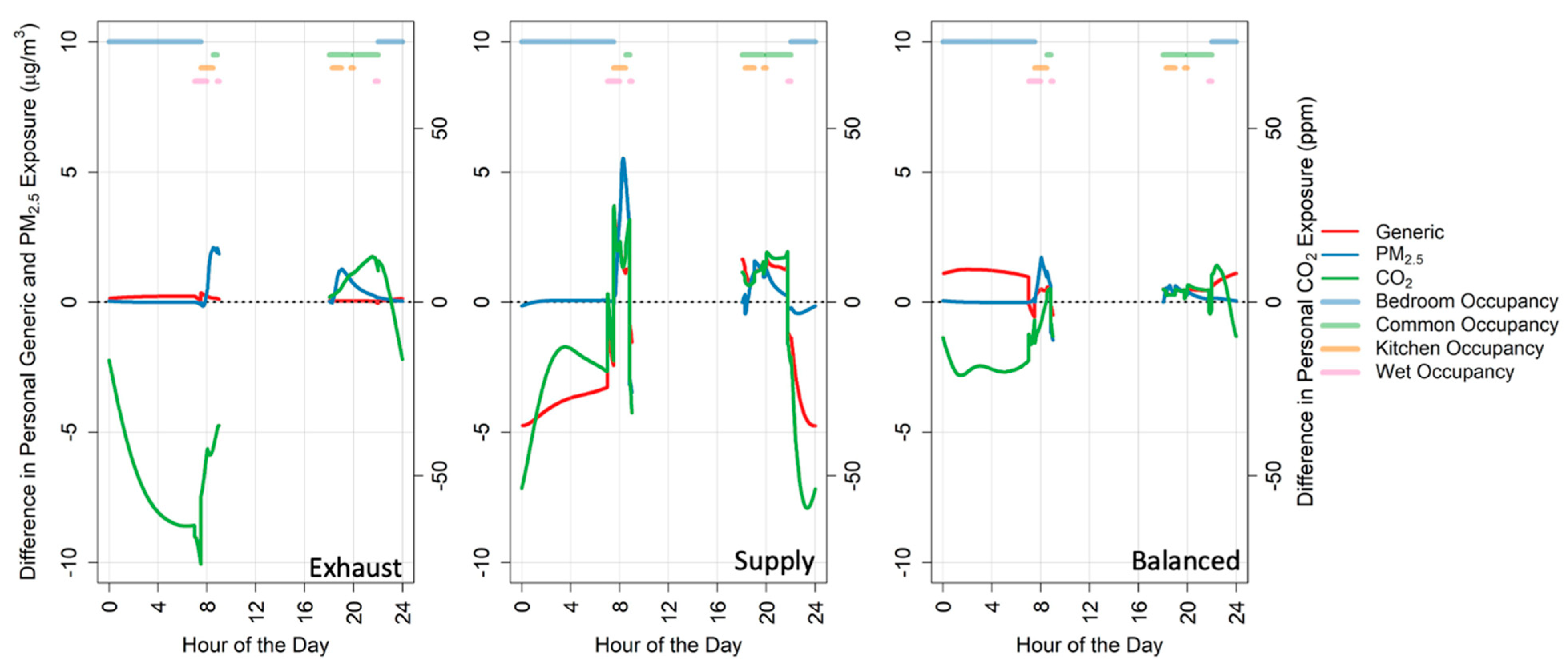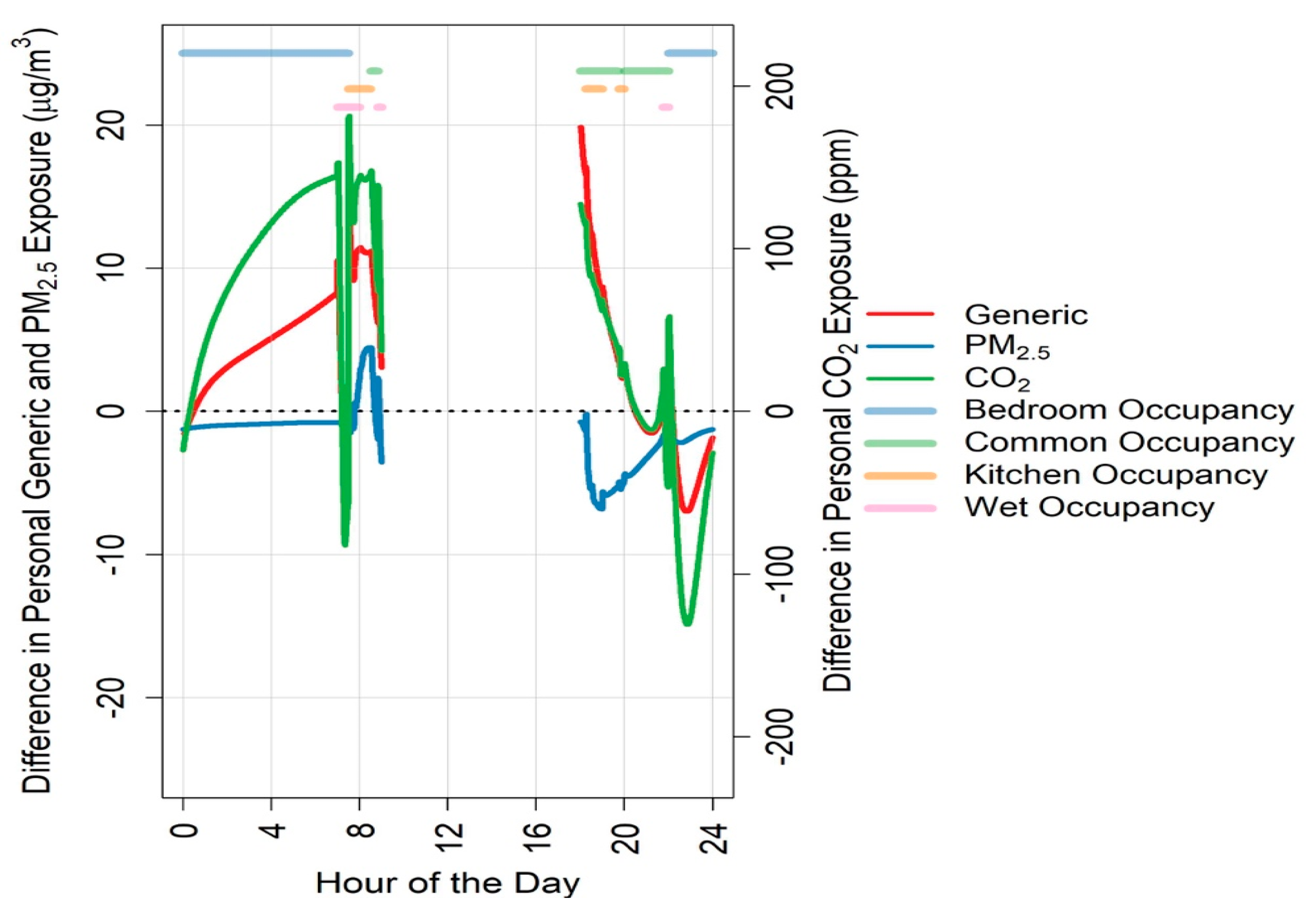Development of Advanced Smart Ventilation Controls for Residential Applications
Abstract
:1. Introduction
2. Multi-Zone Smart Ventilation Control
Smart Control Descriptions
- Baseline + Indoor Air Quality (IAQ) Controls—Intended to improve IAQ while not affecting energy use, these controls do not modulate the total air flow, instead they change which zone(s) the air is supplied to or exhausted from based on occupancy. They are referred to as ‘tracker’ controls, because flows track zone occupancy. They do not use relative exposure calculations to make control decisions.
- ◦
- supplyTracker—For supply and balanced systems only. When the dwelling is vacant, all fan flows are directed to zones proportional to the zone floor area. When the dwelling is occupied the supply air flows are directed to occupied zones, proportional to the number of occupants in each zone. It is possible for a single occupied zone to receive the full dwelling air flow rate.
- ◦
- occupantTracker—Same as the supply tracker, but for exhaust fans, such that the exhaust flows are from each zone according to floor area when the home is vacant, and from each zone according to number of occupants when the home is occupied.
- Outdoor Temperature Controls—These controls use measured outdoor temperatures to shift ventilation flows to mild weather periods. They require pre-optimization to determine how to best scale outside flows with temperature in each dwelling and location. We performed a pre-optimization for all three of the controllers below. All temperature-based controllers operated on real-time zone relative exposure calculations.
- ◦
- varQ—This controller has been found to be highly effective in previous studies. For unzoned systems, the whole dwelling IAQ fan flow rate is varied according to outdoor dry-bulb temperature, using pre-optimized temperature scaling factors. This leads to increased annual ventilation flow.
- ◦
- varQmzSingleZoneOpt—This controller combines the temperature-based air flow changes of VarQ with occupancy sensing and zonal ventilation equipment. This control has the same airflow at each time-step as the varQ, but fan airflows are directed to occupied zones only proportional to the number of occupants in each zone. This leads to increased annual ventilation flow.
- ◦
- varQmz—For zoned systems, this control has the same calculation procedures as varQ, but temperature scaling parameters are optimized for a two-zone dwelling, using assumed occupancy patterns. This approach can decrease annual ventilation flow.
- Zone Occupancy Controls—These controls modulate the total dwelling air flow in response to zone occupancy. The total dwelling air flow is apportioned to each zone based on floor area (when the dwelling is vacant) or based on occupancy (when the dwelling is occupied). For example, if total dwelling air flow is 100 L/s and a zone is 25% of the dwelling floor area then it is assigned 25 L/s during periods of house vacancy. Similarly, if a dwelling has four occupants and three of them are in a single zone, then this zone receives 75% of the dwelling airflow. Each zone is ventilated at a minimum flow rate when unoccupied. These strategies reduce annual ventilation airflow for the dwelling. Controls use either instantaneous and 24-h averaged zone relative exposure, personal relative exposure, or actual generic contaminant predictions.
- ◦
- zoneExposure—Tracks the instantaneous and 24-h averaged zone relative exposure in each zone, and operates the IAQ fan to maintain both metrics below 1 in any zone that is occupied. When vacant, zone relative exposure is controlled to less than 5 to avoid exposure to high contaminant concentrations upon entering a previously unoccupied zone. Figure 1 shows an illustrative flow chart for this zonal controller.
- ◦
- zoneASHQexposure—Same control strategy as zoneExposure, but instead of using controller estimates of instantaneous and 24-h averaged zone relative exposure, it controls the zone generic contaminant concentration (ASHQ) to be the same as the steady-state zone concentration that would occur at the uncontrolled continuous ventilation rate.
- ◦
- occExposure—Tracks controller estimated zone relative exposure in each zone and 24-h averaged personal relative exposure for each occupant. Zones are vented if any person in the zone has a 24-h averaged personal relative exposure greater than 1, or if the zone relative exposure is greater than 1. Unoccupied zone relative exposure is controlled to less than 5 to avoid exposure to high contaminant concentrations upon entering a previously unoccupied zone. This controller ensures that a high personal relative exposure in one zone (e.g., in kitchen while cooking) can be compensated for by increased ventilation and lower relative exposure in another zone.
- ◦
- occASHQexposure—This is the same control strategy as occExposure, but instead of using controller estimates of instantaneous and 24-h averaged personal relative exposure, it controls the zone generic contaminant concentration to be the same as the steady-state zone concentration that would occur at the uncontrolled continuous ventilation rate.
- ◦
- occupantVenter—All zones get a minimum flow rate when unoccupied. Additional airflow is distributed to occupied zones according to the occupant count in each zone. There is no tracking of controller estimated of instantaneous and 24-h averaged personal relative exposure or contaminants.
3. Modeling Approach
- Central exhaust located in the Common living spaces zone (SPexhaust).
- Central supply located in the Common living spaces zone, with MERV13 filtration for the supply air (SPsupply).
- Balanced system, with exhaust flows from Kitchen and Bathroom zones, and supply flows (with MERV 13 filtration) to the Common living spaces and Bedroom zones (SPbalanced).
- Exhaust fans located in each zone of the dwelling, controlled independently (MPexhaust).
- Supply fans located in each zone of the dwelling, controlled independently (MPsupply).
- Balanced supply/exhaust systems located in each zone of the dwelling. Note, this differs from typical balanced systems, which are balanced for the home, but not for each zone in the home. The system studied here is balanced for each zone (MPbalanced).
3.1. Model Input Parameters
3.1.1. Occupancy
3.1.2. CO2
- Adult: 10 mg/s (awake); 6.5 mg/s (asleep)
- Child: 6.5 mg/s (awake); 4 mg/s (asleep)
3.1.3. Moisture
- Per Adult: 15 mg/s (awake); 9 mg/s (asleep)
- Per Child: 10 mg/s (awake); 6 mg/s (asleep)
- Dishwashing: 130 mg/s
- Cooking: 140 mg/s (half of the total of 280 mg/s due to range hood operation)
- Showering: 330 mg/s (half of the total of 660 mg/s due to bathroom exhaust operation), varied according to occupancy
- Background emission: 20 mg/s
3.1.4. Particles (PM2.5)
- PM2.5 cooking: 0.0208 mg/s
- PM2.5 other: 0.00007 mg/s
3.2. Generic Contaminants
3.3. Envelope Leakage
3.4. Weather
4. Results
4.1. Impacts of Zoned Ventilation Configurations
4.2. Summary of Ventilation Controls
4.3. Variability of Results with the Simulation Parameters
5. Conclusions
Author Contributions
Funding
Institutional Review Board Statement
Informed Consent Statement
Data Availability Statement
Acknowledgments
Conflicts of Interest
References
- Guyot, G.; Sherman, M.H.; Walker, I.S. Smart Ventilation Energy and Indoor Air Quality Performance in Residential Buildings: A Review. Energy Build. 2018, 165, 416–430. [Google Scholar] [CrossRef] [Green Version]
- Sherman, M.H.; Walker, I.S. Meeting Residential Ventilation Standards through Dynamic Control of Ventilation Systems. Energy Build. 2011, 43, 1904–1912. [Google Scholar] [CrossRef] [Green Version]
- Sherman, M.H.; Walker, I.S.; Logue, J.M. Equivalence in Ventilation and Indoor Air Quality. HVACR Res. 2012, 18, 760–773. [Google Scholar] [CrossRef]
- Less, B.D.; Dutton, S.M.; Walker, I.S.; Sherman, M.H.; Clark, J.D. Energy Savings with Outdoor Temperature-Based Smart Ventilation Control Strategies in Advanced California Homes. Energy Build. 2019, 194, 317–327. [Google Scholar] [CrossRef] [Green Version]
- Lubliner, M. Energy Savings Potential of Controlling Residential Whole-House Ventilation System Operation Based on Outside Temperature. In Proceedings of the Environmental Health in Low Energy Buildings, Vancouver, BC, Canada, 15–18 October 2013; ASHRAE: Vancouver, BC, Canada, 2013; pp. 215–221. [Google Scholar]
- Walker, I.S.; Sherman, M.; Dickerhoff, D. Development of a Residential Integrated Ventilation Controller; Lawrence Berkeley National Laboratory: Berkeley, CA, USA, 2012. [Google Scholar]
- Less, B.; Walker, I.S.; Tang, Y. Development of an Outdoor Temperature-Based Control. Algorithm for Residential Mechanical Ventilation Control; Lawrence Berkeley National Laboratory: Berkeley, CA, USA, 2014. [Google Scholar]
- Less, B.; Walker, I.S.; Ticci, S. Development of Smart Ventilation Control Algorithms for Humidity Control in High-Performance Homes in Humid U.S. Climates; Lawrence Berkeley National Laboratory: Berkeley, CA, USA, 2016. [Google Scholar]
- Less, B.; Walker, I.S. Smart Ventilation Controls for Occupancy and Auxiliary Fan Use across U.S. Climates; Lawrence Berkeley National Laboratory: Berkeley, CA, USA, 2017. [Google Scholar]
- Clark, J.D.; Less, B.D.; Dutton, S.M.; Walker, I.S.; Sherman, M.H. Efficacy of Occupancy-Based Smart Ventilation Control Strategies in Energy-Efficient Homes in the United States. Build. Environ. 2019, 156, 253–267. [Google Scholar] [CrossRef] [Green Version]
- Martin, E.; Fenaughty, K.; Parker, D. Field and Laboratory Testing of Approaches to Smart Whole-House Mechanical Ventilation Control; National Renewable Energy Laboratory: Golden, CO, USA, 2018. [Google Scholar]
- Turner, W.J.N.; Walker, I.S. Using a Ventilation Controller to Optimise Residential Passive Ventilation for Energy and Indoor Air Quality. Build. Environ. 2013, 70, 20–30. [Google Scholar] [CrossRef]
- Young, M.; Less, B.D.; Dutton, S.M.; Walker, I.S.; Sherman, M.H.; Clark, J.D. Assessment of Peak Power Demand Reduction Available via Modulation of Building Ventilation Systems. Energy Build. 2020, 214, 109867. [Google Scholar] [CrossRef]
- Less, B.; Walker, I.; Lorenzetti, D.; Mills, E.; Rapp, V.; Dutton, S.; Sohn, M.; Li, X.; Clark, J.; Sherman, M.; et al. Smart Ventilation for Advanced California Homes; LBNL-2001342; 2020. Available online: https://www.osti.gov/biblio/1635274/ (accessed on 1 June 2020).
- Offermann, F.J. Ventilation and Indoor Air Quality in New Homes; California Energy Commission and California Air Resources Board: Sacramento, CA, USA, 2009. [Google Scholar]
- Hult, E.L.; Willem, H.; Price, P.N.; Hotchi, T.; Russell, M.L.; Singer, B.C. Formaldehyde and Acetaldehyde Exposure Mitigation in US Residences: In-Home Measurements of Ventilation Control and Source Control. Indoor Air 2015, 25, 523–535. [Google Scholar] [CrossRef] [PubMed] [Green Version]
- Persily, A. A Modeling Study of Ventilation, IAQ and Energy Impacts of Residential Mechanical Ventilation; National Institute of Standards and Technology: Gaithersburg, MD, USA, 1998. [Google Scholar]
- Emmerich, S.; Howard-Reed, C.; Gupte, A. Modeling the IAQ Impact of HH1 Interventions in Inner-City Housing; National Institute of Standards and Technology: Gaithersburg, MD, USA, 2005. [Google Scholar]
- California Energy Commission. Alternative Calculation Method Approval Manual for the 2019 Building Energy Efficiency Standards—Title 24, Part. 6, and Associated Administrative Regulaions in Part. 1; California Energy Commission: Sacramento, CA, USA, 2018. [Google Scholar]
- Emrath, P. Berkeley Spaces in New Homes; National Association of Home Builders: Washington, DC, USA, 2013. [Google Scholar]
- ASHRAE Standard 62.2. Ventilation and Acceptable Indoor Air Quality in Residential Buildings; American Society of Heating Refrigeration and Airconditioning Engineers: Atlanta, GA, USA, 2019. [Google Scholar]
- HVI. Certified Home Ventilating Products Directory; Home Ventilating Institute: Cheyenne, WY, USA, 2019. [Google Scholar]
- Kim, S.; Walker, I.; Delp, W. Development of a Standard Test. Method for Reducing the Uncertainties in Measuring the Capture Efficiency of Range Hoods; Lawrence Berkeley National Laboratory: Berkeley, CA, USA, 2017; p. 39. [Google Scholar]
- ASHRAE Standard 160. Criteria for Moisture Control Design Analysis in Buildings; American Society of Heating Refrigeration and Airconditioning Engineers: Atlanta, GA, USA, 2016. [Google Scholar]
- Woods, J.; Winkler, J. Effective Moisture Penetration Depth Model for Residential Buildings: Sensitivity Analysis and Guidance on Model Inputs. Energy Build. 2018, 165, 216–232. [Google Scholar] [CrossRef]
- Woods, J.; Winkler, J.; Christensen, D. Moisture Modeling: Effective Moisture Penetration Depth versus Effective Capacitance. In Proceedings of the Thermal Performance of Exterior Envelopes of Whole Buildings XII; ASHRAE/DOE/BTECC: Clearwater Beach, FL, USA; American Society of Heating Refrigeration and Airconditioning Engineers: Atlanta, GA, USA, 2013. [Google Scholar]
- Chan, W.R.; Kim, Y.-S.; Less, B.D.; Singer, B.C.; Walker, I.S. Ventilation and Indoor Air Quality in New California Homes with Gas. Appliances and Mechanical Ventilation; LBNL-2001200; Lwrence Berkeley National Laboratory: Berkeley, CA, USA, 2019. [Google Scholar] [CrossRef]






| Zone Name | Single-Family (%) | 1-Story (m2) | 2-Story (m2) | Apartment (%) | Apartment (m2) |
|---|---|---|---|---|---|
| Bedrooms | 29% | 56 | 72 | 37% | 30 |
| Wet Rooms (Bath and Laundry) | 16% | 31 | 40 | 8% | 6 |
| Common | 44% | 85 | 109 | 44% | 35 |
| Kitchen | 11% | 23 | 29 | 11% | 9 |
| TOTAL | 100% | 195 | 251 | 100% | 81 |
| Common (L/s) | Bedroom (L/s) | Kitchen (L/s) | Wet (L/s) | Total Exhaust (L/s) | Total Supply (L/s) | |||||
|---|---|---|---|---|---|---|---|---|---|---|
| Fan Type | Exh | Sup | Exh | Sup | Exh | Sup | Exh | Sup | ||
| SPexhaust | 43 | 0 | 0 | 0 | 0 | 0 | 0 | 0 | 43 | 0 |
| SPsupply | 0 | 43 | 0 | 0 | 0 | 0 | 0 | 0 | 0 | 43 |
| SPbalanced | 0 | 23 | 0 | 15 | 16 | 0 | 22 | 0 | 39 | 39 |
| MPexhaust | 19 | 0 | 12 | 0 | 5 | 0 | 7 | 0 | 43 | 0 |
| MPsupply | 0 | 19 | 0 | 12 | 0 | 5 | 0 | 7 | 0 | 43 |
| MPbalanced | 6 | 6 | 11 | 11 | 17 | 17 | 4 | 4 | 39 | 39 |
| Fan Type | Prototype | Generic | PM2.5 | CO2 | RH > 60% | |||||||||
|---|---|---|---|---|---|---|---|---|---|---|---|---|---|---|
| Single-Point Concentration (μg/m3) | Zoned-SP | Change (%) | Single-Point Concentration (μg/m3) | Zoned-SP | Change (%) | Single-Point Concentration (ppm) | Zoned-SP | Change (%) | Change (%) from 400 ppm Baseline | Single-Point RH > 60% (Zone Hours) | Zoned-SP | Change (%) | ||
| Balanced | 1-story | 18.5 | 0.83 | 4% | 11.5 | 0.16 | 1% | 753 | −8 | −1% | −2% | 415 | 95 | 23% |
| 2-story | 20.5 | 0.75 | 4% | 12.2 | 0.07 | 1% | 774 | 2 | 0% | 1% | 156 | 48 | 31% | |
| Apt | 12.7 | 1.24 | 10% | 20.1 | 0.60 | 3% | 1021 | 42 | 4% | 7% | 227 | 70 | 31% | |
| Exhaust | 1-story | 20.0 | 0.13 | 1% | 12.0 | 0.28 | 2% | 783 | −27 | −3% | −7% | 557 | −51 | −9% |
| 2-story | 25.0 | −2.11 | −9% | 11.4 | 1.32 | 11% | 904 | −84 | −9% | −17% | 312 | −69 | −22% | |
| Apt | 12.9 | 0.15 | 1% | 21.9 | 0.22 | 1% | 1030 | −13 | −1% | −2% | 304 | −18 | −6% | |
| Supply | 1-story | 22.7 | −1.30 | −6% | 11.8 | 0.21 | 2% | 772 | −3 | 0% | −1% | 557 | 12 | 2% |
| 2-story | 25.3 | −2.33 | −9% | 12.5 | 0.17 | 1% | 813 | −24 | −3% | −6% | 170 | 65 | 38% | |
| Apt | 18.0 | −2.55 | −14% | 21.9 | 0.17 | 1% | 1067 | −34 | −3% | −5% | 307 | 1 | 0% | |
| Average | 19.5 | −0.6 | −2% | 15.0 | 0.4 | 3% | 880 | −17 | −2% | −4% | 334 | 17 | 10% | |
| Variable | Value | Personal Concentrations | Personal Concentration Ratios | Total HVAC Energy Savings | Ventilation Rate (h−1) | Reduction in Ventilation Rate (%) | |||||
|---|---|---|---|---|---|---|---|---|---|---|---|
| Generic (μg/m3) | PM2.5 (μg/m3) | CO2 (ppm) | Generic | PM2.5 | CO2 | kWh/m2 | % | ||||
| baseNoFan | Baseline | 71.8 | 14.8 | 1481 | 3.75 | 1.24 | 1.83 | 2.66 | 36% | 0.085 | 73% |
| baseFan | Baseline | 20.9 | 12.3 | 783 | 1.00 | 1.00 | 1.00 | 0.00 | 0% | 0.302 | 0% |
| occupantVenter | ZoneOcc | 24.0 | 12.5 | 799 | 1.12 | 1.02 | 1.01 | 1.66 | 19% | 0.279 | 30% |
| varQmz | Temp | 27.5 | 12.4 | 836 | 1.30 | 0.99 | 1.06 | 1.83 | 18% | 0.215 | 10% |
| occASHQexposure | ZoneOcc | 24.7 | 12.2 | 797 | 1.18 | 0.99 | 1.03 | 1.64 | 17% | 0.230 | 25% |
| zoneASHQexposure | ZoneOcc | 24.4 | 11.9 | 798 | 1.17 | 0.97 | 1.03 | 1.51 | 15% | 0.233 | 24% |
| occExposure | ZoneOcc | 23.9 | 11.3 | 798 | 1.14 | 0.90 | 1.04 | 1.12 | 11% | 0.251 | 18% |
| zoneExposure | ZoneOcc | 24.0 | 11.2 | 802 | 1.15 | 0.90 | 1.04 | 1.04 | 11% | 0.253 | 18% |
| varQ | Temp | 21.1 | 11.7 | 788 | 0.98 | 0.97 | 0.99 | 0.60 | 7% | 0.353 | −14% |
| varQmzSingleZoneOpt | Temp | 19.2 | 11.9 | 726 | 0.93 | 0.97 | 0.94 | 0.52 | 6% | 0.354 | −14% |
| supplyTracker | Tracker | 15.6 | 11.9 | 706 | 0.81 | 0.99 | 0.91 | −0.01 | 0% | 0.322 | 0% |
| occupantTracker | Tracker | 18.7 | 12.1 | 710 | 0.91 | 0.97 | 0.91 | −0.03 | 0% | 0.302 | 0% |
| Control Name | Control Category | 24-h Mean PM2.5 > 35 μg/m3 (Personal Hours) | 24-h Mean PM2.5 > 25 μg/m3 (Personal Hours) | CO2 > 5000 ppm (Zone Hours) | RH > 60% (Zone Hours) |
|---|---|---|---|---|---|
| baseNoFan | Baseline | 11 | 13 | 0 | 6444 |
| baseFan | Baseline | 8 | 12 | 0 | 294 |
| occupantVenter | ZoneOcc | 9 | 12 | 0 | 367 |
| varQmz | Temp | 11 | 13 | 0 | 345 |
| occASHQexposure | ZoneOcc | 9 | 12 | 0 | 375 |
| zoneASHQexposure | ZoneOcc | 9 | 12 | 0 | 355 |
| occExposure | ZoneOcc | 8 | 12 | 0 | 338 |
| zoneExposure | ZoneOcc | 8 | 12 | 0 | 335 |
| varQ | Temp | 10 | 13 | 0 | 335 |
| varQmzSingleZoneOpt | Temp | 10 | 13 | 0 | 341 |
| supplyTracker | Tracker | 8 | 13 | 0 | 248 |
| occupantTracker | Tracker | 8 | 12 | 0 | 309 |
| Variable | Value | Personal Concentrations | Personal Concentration Ratios | Total HVAC Energy Savings | Ventilation Rate (h−1) | |||||
|---|---|---|---|---|---|---|---|---|---|---|
| Generic (μg/m3) | PM2.5 (μg/m3) | CO2 (ppm) | Generic | PM2.5 | CO2 | kWh/m2 | % | |||
| Prototype | 1 story | 24.1 | 11.5 | 783 | 1.154 | 0.963 | 1.036 | 1.17 | 14% | 0.26 |
| 2 story | 24.8 | 11.9 | 787 | 1.096 | 0.966 | 0.998 | 1.38 | 12% | 0.24 | |
| apt | 18.2 | 20.5 | 1093 | 1.214 | 0.974 | 1.050 | −0.07 | −1% | 0.32 | |
| Fan Type | Exhaust | 24.5 | 12.2 | 782 | 1.194 | 0.972 | 0.997 | 0.75 | 10% | 0.26 |
| Supply | 24.2 | 12.0 | 812 | 1.091 | 0.960 | 1.033 | 1.31 | 12% | 0.24 | |
| Balanced | 22.8 | 11.6 | 784 | 1.143 | 0.962 | 1.012 | 1.42 | 14% | 0.27 | |
| ACH50 | 0.6 | 24.4 | 11.4 | 789 | 1.160 | 0.952 | 1.020 | 1.28 | 13% | 0.24 |
| 2 | 24.5 | 11.7 | 788 | 1.128 | 0.965 | 1.014 | 1.30 | 13% | 0.25 | |
| 3 | 22.1 | 12.9 | 802 | 1.115 | 0.973 | 1.014 | 0.77 | 9% | 0.27 | |
| Climate Zone | 1 | 22.9 | 11.7 | 786 | 1.129 | 0.968 | 1.022 | 1.15 | 11% | 0.26 |
| 3 | 23.1 | 11.9 | 785 | 1.139 | 0.965 | 1.021 | 0.81 | 13% | 0.26 | |
| 10 | 24.3 | 12.1 | 795 | 1.137 | 0.964 | 1.013 | 0.72 | 11% | 0.25 | |
| 16 | 24.7 | 12.5 | 812 | 1.115 | 0.965 | 1.010 | 1.95 | 11% | 0.26 | |
| HVAC Mixed and Filtered MERV13 | Yes | 24.0 | 11.0 | 793 | 1.131 | 0.967 | 1.019 | 1.25 | 11% | 0.26 |
| No | 24.0 | 12.8 | 795 | 1.126 | 0.965 | 1.013 | 0.97 | 12% | 0.26 | |
| Control Zones | 2 | 23.0 | 12.0 | 786 | 1.105 | 0.973 | 1.005 | 0.96 | 10% | 0.27 |
| 4 | 24.4 | 11.8 | 804 | 1.174 | 0.944 | 1.036 | 1.33 | 14% | 0.24 | |
Publisher’s Note: MDPI stays neutral with regard to jurisdictional claims in published maps and institutional affiliations. |
© 2021 by the authors. Licensee MDPI, Basel, Switzerland. This article is an open access article distributed under the terms and conditions of the Creative Commons Attribution (CC BY) license (https://creativecommons.org/licenses/by/4.0/).
Share and Cite
Walker, I.; Less, B.; Lorenzetti, D.; Sohn, M.D. Development of Advanced Smart Ventilation Controls for Residential Applications. Energies 2021, 14, 5257. https://doi.org/10.3390/en14175257
Walker I, Less B, Lorenzetti D, Sohn MD. Development of Advanced Smart Ventilation Controls for Residential Applications. Energies. 2021; 14(17):5257. https://doi.org/10.3390/en14175257
Chicago/Turabian StyleWalker, Iain, Brennan Less, David Lorenzetti, and Michael D. Sohn. 2021. "Development of Advanced Smart Ventilation Controls for Residential Applications" Energies 14, no. 17: 5257. https://doi.org/10.3390/en14175257
APA StyleWalker, I., Less, B., Lorenzetti, D., & Sohn, M. D. (2021). Development of Advanced Smart Ventilation Controls for Residential Applications. Energies, 14(17), 5257. https://doi.org/10.3390/en14175257






